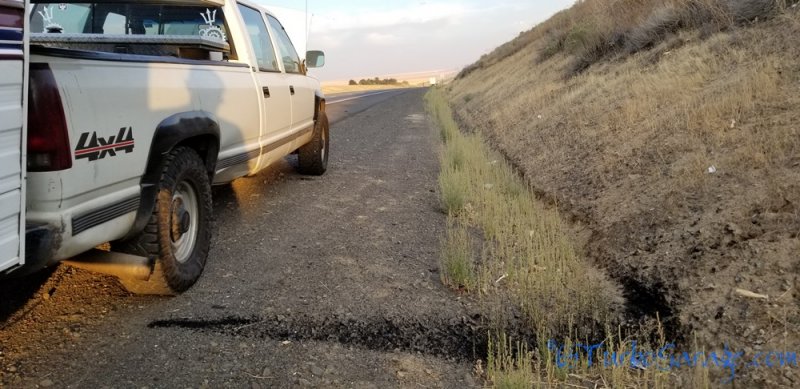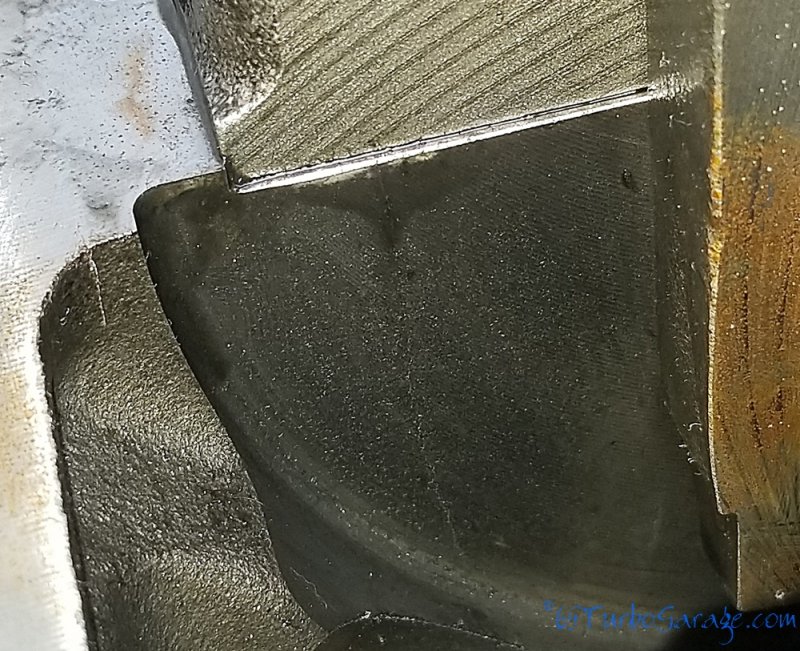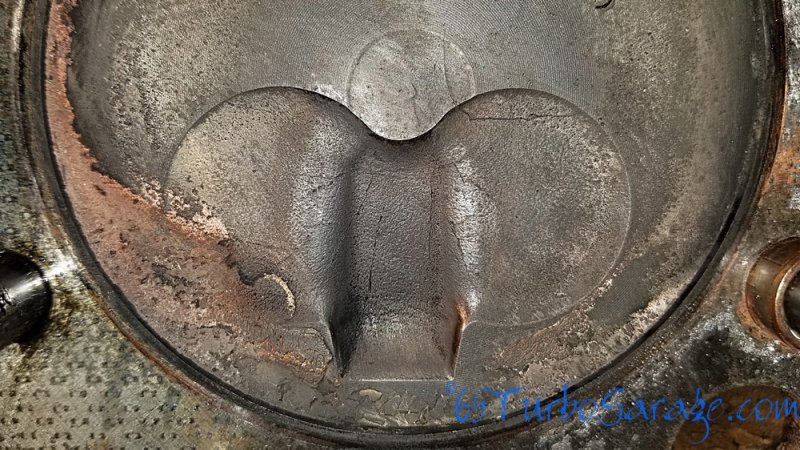Hink
Overkill Is Underrated
Hey all,
I've finally had the time to sit down and start getting a condensed version of what led up to my current build and I'll add more as I get further along.
So to start, I have been running an Optimizer that I added all the improvements that you see in my signature. All of which were added to make the truck run strong for many thousands of miles.
Well, basically, I can break pretty much anything.
At the end of this last summer, I was hauling my RV to Eastern Washington to see friends for a end of summer trip. I needed to get under the hood to do something and in doing so, pushed a plastic fitting in the heater core line up against the turbo which decided to melt and explode right when I was cresting a hill under full power.

Result; head gasket blown out about 1/2" out from under the head at the #8
After getting it home, I pulled the motor and found further carnage.
Let me tell you this, don't let anyone tell you that Optimizer blocks don't crack.
- I had main web cracks at the outside bolts on the three inner webs with the #2 web cracked so bad that it likely would have fallen into the oil pan in short order.

- I also had spider cracks on all 8 piston tops with pitting and large erosion at the edge where it scuffed the cylinder wall.

- My DSG timing gears also self destructed and lost a snap ring that ended up in the oil pan.
So what the hell happened to this motor?
Me. I'm what happened to this motor.
Again, a condensed version...
The motor was a military take out from Ted's and was in great shape, I would buy another from them again (as a matter of fact, I plan on it). But who knows what kind of life it had before I got it?
I removed the heads to install ARP head studs and was reminded of a couple things that I didn't like...
- This motor came out of a naturally aspirated HMMWV. The concern here was that the pistons were not coated like the turbo versions are. After a bit of research, I found the consensus was that they would would be fine. And in truth, they would be fine in an otherwise stock motor, but this thing wasn't going to be very stock.
- Also being naturally aspirated, the heads had some of the smallest precups made for these
motors. I believe the theory that they run hotter and certainly don't allow for as much power as the later design precups.
There were several other major issues that all conspired in the destruction of my block and pistons.
- I had bumped up the timing quite a while ago. But, a few pictures of some other's failed pistons caught my eye. They looked a lot like mine with spider web cracks and they had obviously been heated to an extreme degree.
Advanced timing was identified as the culprit.
- This was all before I solved my overheating issues with so all the heat attacking the piston tops wasn't able to be removed.
- The first day I had it running, the upper radiator hose comes off and I subject my motor to it's first thermal shock.
- The injectors I ended up using were rebuilt by a local shop and I was always unhappy with them and we all know that bad injectors can destroy a motor.
And let's not forget that this motor was hydrolocked at one point.
The water/meth cools everything down and helps prevent pre ignition so that likely actually helped.
The last bit of damage was when installing timing gears I couldn't get the idler gears in so I installed a smaller gear.
Some time after getting the truck back on the road, I realized what I had done wrong during install which meant that I likely had an idler gear that was too small.
Sure enough, when I removed the oil pan at the start of the teardown, there was that ear to a circlip at the bottom of the pan.
The gears had fit so loose that they wobbled around in there and eventually broke the clip, allowing the gear axles to ruin the housing they ride in and some metal to get into the bearings.
Luckily, no damage to the crank, rods, or any other hard part could be found.
I am pretty surprised at the amount of cracking the block showed though. But with all the abuse that I put it through, and how horribly out of balance these engines are normally and the fact that I had no opportunity to magnaflux this block to check for cracks before the build, I guess it's not too hard to accept.
So now, the plan...
- I'll reuse the cam, crank, and rods.
- I went into the new block and smoothed all sharp edges to remove any stress risers and beveled/smoothed all main bearing bolt holes that could aid in the start of any cracks.
- I'll fix the problem areas and improve others while I'm in there.
And I did something that I'm really excited about and that is balancing. I got the whole rotating assembly balanced so it'll run super smooth! I firmly believe that this will go a long way to help prevent any block cracks.
- I went with a GM OE piston and a full complement of the best ceramic coatings that can be found from @Twisted Steel Performance .
- I had a set of double square "T" precups on hand from a turbo '93 that are a big improvement over the old NA precups that I was running.
- I will still have the timing advanced, but only just a bit.
- I had already completely solved my heating issues starting with the standard heating upgrades and ending with Twisted Steel's thermal dispersant coated Champion radiator.
- In place of the crappy injectors, I got the best ones that I know of for the 6.5 that you can get from Kris Stratton.
- I tracked the hydrolock issues to Faulty AEM nozzles so I replaced them with much better Devils own nozzles and solenoid to completely eliminate the possibility of it happening again.
- I'll install Leroy's timing gear set. Properly this time.
Tonight I painted the block, and tomorrow I hope to start with assembly!!
I've finally had the time to sit down and start getting a condensed version of what led up to my current build and I'll add more as I get further along.
So to start, I have been running an Optimizer that I added all the improvements that you see in my signature. All of which were added to make the truck run strong for many thousands of miles.
Well, basically, I can break pretty much anything.
At the end of this last summer, I was hauling my RV to Eastern Washington to see friends for a end of summer trip. I needed to get under the hood to do something and in doing so, pushed a plastic fitting in the heater core line up against the turbo which decided to melt and explode right when I was cresting a hill under full power.

Result; head gasket blown out about 1/2" out from under the head at the #8
After getting it home, I pulled the motor and found further carnage.
Let me tell you this, don't let anyone tell you that Optimizer blocks don't crack.
- I had main web cracks at the outside bolts on the three inner webs with the #2 web cracked so bad that it likely would have fallen into the oil pan in short order.

- I also had spider cracks on all 8 piston tops with pitting and large erosion at the edge where it scuffed the cylinder wall.

- My DSG timing gears also self destructed and lost a snap ring that ended up in the oil pan.
So what the hell happened to this motor?
Me. I'm what happened to this motor.
Again, a condensed version...
The motor was a military take out from Ted's and was in great shape, I would buy another from them again (as a matter of fact, I plan on it). But who knows what kind of life it had before I got it?
I removed the heads to install ARP head studs and was reminded of a couple things that I didn't like...
- This motor came out of a naturally aspirated HMMWV. The concern here was that the pistons were not coated like the turbo versions are. After a bit of research, I found the consensus was that they would would be fine. And in truth, they would be fine in an otherwise stock motor, but this thing wasn't going to be very stock.
- Also being naturally aspirated, the heads had some of the smallest precups made for these
motors. I believe the theory that they run hotter and certainly don't allow for as much power as the later design precups.
There were several other major issues that all conspired in the destruction of my block and pistons.
- I had bumped up the timing quite a while ago. But, a few pictures of some other's failed pistons caught my eye. They looked a lot like mine with spider web cracks and they had obviously been heated to an extreme degree.
Advanced timing was identified as the culprit.
- This was all before I solved my overheating issues with so all the heat attacking the piston tops wasn't able to be removed.
- The first day I had it running, the upper radiator hose comes off and I subject my motor to it's first thermal shock.
- The injectors I ended up using were rebuilt by a local shop and I was always unhappy with them and we all know that bad injectors can destroy a motor.
And let's not forget that this motor was hydrolocked at one point.
The water/meth cools everything down and helps prevent pre ignition so that likely actually helped.
The last bit of damage was when installing timing gears I couldn't get the idler gears in so I installed a smaller gear.
Some time after getting the truck back on the road, I realized what I had done wrong during install which meant that I likely had an idler gear that was too small.
Sure enough, when I removed the oil pan at the start of the teardown, there was that ear to a circlip at the bottom of the pan.
The gears had fit so loose that they wobbled around in there and eventually broke the clip, allowing the gear axles to ruin the housing they ride in and some metal to get into the bearings.
Luckily, no damage to the crank, rods, or any other hard part could be found.
I am pretty surprised at the amount of cracking the block showed though. But with all the abuse that I put it through, and how horribly out of balance these engines are normally and the fact that I had no opportunity to magnaflux this block to check for cracks before the build, I guess it's not too hard to accept.
So now, the plan...
- I'll reuse the cam, crank, and rods.
- I went into the new block and smoothed all sharp edges to remove any stress risers and beveled/smoothed all main bearing bolt holes that could aid in the start of any cracks.
- I'll fix the problem areas and improve others while I'm in there.
And I did something that I'm really excited about and that is balancing. I got the whole rotating assembly balanced so it'll run super smooth! I firmly believe that this will go a long way to help prevent any block cracks.
- I went with a GM OE piston and a full complement of the best ceramic coatings that can be found from @Twisted Steel Performance .
- I had a set of double square "T" precups on hand from a turbo '93 that are a big improvement over the old NA precups that I was running.
- I will still have the timing advanced, but only just a bit.
- I had already completely solved my heating issues starting with the standard heating upgrades and ending with Twisted Steel's thermal dispersant coated Champion radiator.
- In place of the crappy injectors, I got the best ones that I know of for the 6.5 that you can get from Kris Stratton.
- I tracked the hydrolock issues to Faulty AEM nozzles so I replaced them with much better Devils own nozzles and solenoid to completely eliminate the possibility of it happening again.
- I'll install Leroy's timing gear set. Properly this time.
Tonight I painted the block, and tomorrow I hope to start with assembly!!
